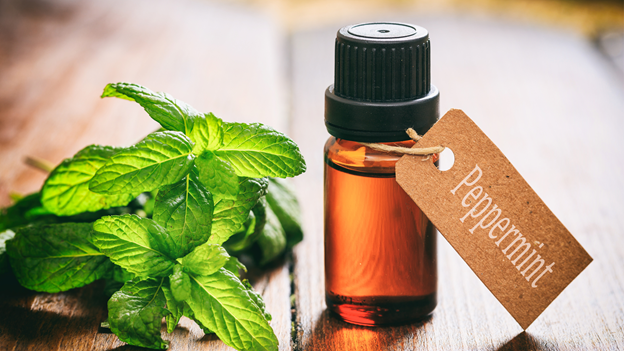Peppermint oil is generally obtained from the peppermint plant. Among the essential oils for fever, peppermint oil is considered essential and effective in treating a medical condition like a fever. The common symptoms of fever include headache and muscle aches.
Treating medical conditions with essential oils is considered an alternative treatment to be viewed by the medical community.
What are essential oils?
Essential oils are concentrated oils that contain substances with the characteristics of flavor and odor enhancement. Essential oils that are obtained by chemical processing are not true essential oils because they are obtained through the distillation process or mechanical approaches like cold pressing.
Although there are 90 types of essential oil and each has potential benefits related to health. In a review on Healthline, peppermint oil is among the top popular essential oils with sandalwood and lavender.
Many essential oils for fever have been reported because of their antiviral property, which helps treat infections and reduce fever. Such essential oils for fevers treatment mainly include cinnamon oil, ginger oil, peppermint oil, tea tree oil, eucalyptus oil, lavender oil, etc.
Among all the essential oils, this article would discuss the uses and benefits of peppermint oil for fevers.

What is Peppermint oil?
The scientific name of the Peppermint plant is Mentha x piperita. The x in the scientific name of peppermint indicates a hybrid. Peppermint is an aromatic herb and belongs to the mint family. It is a cross between watermint and spearmint. It is grown in the European and North American regions.
Peppermint oil is different from its extract because peppermint oil retains the volatile aromatic compounds present in the peppermint plants. This is done through the process of distillation.
The essential oil from peppermint is extracted from the peppermint plant leaves, which can be used for various health purposes. Records for the use of peppermint have been found for thousands of years from ancient Egypt, Rome, and Greece.
According to the study on essential oils, peppermint oil contains menthol, limonene, and menthone.
It is a low-priced and extremely accessible product that is easy to use for the treatment of fever.
However, peppermint oil has been used in aromatherapy to treat conditions like stress, improve mental function, reduce pain, and treat colds and coughs.
Peppermint oil is highly promoted for topical use against issues like itching, joint pain, muscle aches, and headache. Additionally, peppermint oil is known to treat symptoms of fever such as headache and muscle aches.
Forms of peppermint oil
The extraction of peppermint oil from peppermint plants can be found as products available for use in different forms. The availability of peppermint oil is in the form of:
- Essential oils are to be used in aromatherapy, topical use, or diluted form with carrier oils.
- Extracts – it is a diluted form for the addition of peppermint flavor in the foods.
- Capsules – used as dietary supplements.

Benefits of Peppermint oil:
One of the most effective essential oils for fever is peppermint oil, used as a fever reducer. Considering the symptoms of fever, which mainly includes headache and muscle pain, peppermint oil has known to be effective in treating fever because it is one of the popular essential oils for fever.
Many factors can induce fever, which includes overexposure of skin to sunlight, dehydration, and infection.
Peppermint oil is known to provide quick relief from fever as compared to fever-reducing medicines such as Tylenol.
1. Relieves headache
The menthol in peppermint oil and wintergreen oil is used to treat pain from migraine headaches, tension headaches, and other related conditions.
In a 2016 study, it has been suggested that the topical use of peppermint oil assists in relaxing muscles and alleviating pain. Menthol’s cooling properties help ease migraine headache or tension headache pain when applied to temples or forehead.
According to a study, peppermint oil application has been proven as an alternative and cost-effective treatment for headache pain.
A randomized control trial in the International Journal of clinical practice studied the topical application of 10 percent menthol solution to treat migraine. Because menthol is the active ingredient in peppermint oil, its use on the temples and forehead relieved pain and reduced nausea and sensitivity compared to placebo.
As an essential oil for fever, peppermint oil helps in cooling the high temperature of the skin and the body when an individual has a fever.
Thus, peppermint acts as a pain reliever and muscle relaxant and helps relieve different types of headaches associated with different health conditions such as fever. Rubbing peppermint oil on the skin would help in alleviating the symptoms of fever.
2. Soothes muscle pain
Most of the pain-relieving sprays are known to contain some amount of peppermint oil. It induces a burning sensation and relieves the pain at the same time. Undoubtedly, it has been known to act as a pain killer and helps in soothing sore muscles.
To soothe muscle soreness and tension, add five drops of peppermint oil with a carrier oil and massage it on the affected area.
3. Improves breath
One of the reasons behind the popular use of peppermint oil is its taste, pleasant scent, and cleanliness. Using peppermint in the form of tea helps in freshening the breath of an individual. Thus, it provides benefits associated with bad breath.
For instance, a research study reported that gargling oils extracted from peppermint, tea tree, and lemon helped improve bad breath.
Similarly, it has also been suggested in a 2015 review that the antibacterial properties of peppermint oil help reduce the bacterial growth that causes gum disease and plaque.
4. Improves digestion
The use of peppermint has been known for years to treat digestive issues like gas, bloating, and upset stomach. According to the research studies, it has been suggested that the intake of peppermint oil in the form of capsules brings a significant reduction in children who suffer from an abdominal pain disorder.
5. Reduce menstrual cramps
The other benefit of peppermint oil helps in reducing severe conditions like dysmenorrhea or menstrual cramps.
In a study, 127 young women participated who had dysmenorrhea to evaluate the effectiveness of peppermint oil. Based on the study outcomes, the peppermint oil capsules had been as effective to relieve menstrual pain as mefenamic acid (a type of NSAID).
6. More energy
Peppermint oil is used in alleviating fatigue symptoms and helps in boosting energy levels. According to a study, the use of peppermint oil capsules brought a significant reduction in mental fatigue and improved cognitive function compared to a placebo.
Because not much research has been conducted to evaluate peppermint oil’s effect in boosting energy levels, more research is needed to confirm the findings.

How to use the peppermint oil?
Using peppermint oil is easy. There are different ways to use peppermint oil to experience its health benefits. The use of peppermint oil depends on how you would prefer it for use. Because drinking 26 cups of peppermint is equal to one drop of peppermint oil. Peppermint oil is more effective for instant relief than peppermint tea. Thus, the following are some ways to use peppermint oil as an essential oil for fever.
- Applying peppermint oil helps in increasing the blood flow and warming up the body. This leads to sweating and works in balancing out the temperature of the body. Drying out of sweat effectively helps in bringing down a fever.
- The other way to ease the chills requires a warm compress. For this purpose, add a few drops of peppermint oil and cinnamon oil to a bowl of warm water. Soak washcloths, apply the cloth at the back of the neck and on the forehead.
- Use only one drop of peppermint oil in a cup of hot water or tea. It relieves discomfort in the stomach or warms the body, which helps in sweating out the fever.
- Applying five drops of peppermint oil at the bottom of your feet will help alleviate fever and nausea symptoms, including pain and body ache.
- To relieve headaches, pain, and fever, applying two drops of peppermint oil with a carrier oil and massaging it on the temples and forehead relieves the pain. Using peppermint oil would help in relaxing the body and mind. This allows the body and mind to fight effectively against fever.
- Tepid compressing with peppermint oil can be used to relieve fever fast.
- Peppermint oil in the form of a supplement can be taken to prevent conditions like fevers and colds. Taking peppermint oil in the form of capsules improves the immune system and helps fight off virus attacks.
For children
The dosage of many medicinal substances varies concerning the age of the patient. Due to this reason, the use of peppermint oil is different as compared to its use for adults.
It should not be used for children under the age of 6 years.
You can dilute two drops of peppermint oil with a carrier oil and then massage it behind the ears or apply it on the back, neck, and feet.
Carrier oil with peppermint oil
Pure essential oils for topical use should be avoided and used with a carrier oil to make dilutions. For this purpose, the carrier oils to dilute essential oils include olive oil, sesame oil, coconut oil, and almond oil.
Note: Massaging the peppermint oil should be continued after every hour until the fever breaks. It can also be applied on the spine, feet, or navel and every 10-15 minutes if necessary.
Contradictions
Like other essential oils, the use of peppermint oil can produce toxic and even lethal effects when exceeding the recommended dose. Exceeding the average dosage of peppermint oil tends to be associated with medical problems like acute renal failure and interstitial nephritis.
It can also produce a choleretic effect and leads to contradictions in cholecystitis and cholelithiasis patients. Similarly, it is relatively contradicted with GERD and hiatal hernia because it affects the lower esophageal sphincter and worsens symptoms.
Because the use of peppermint oil triggers menstruation, it should be avoided in pregnancy. Also, its use in the lactation period is not well studied to confirm its safe use.
The peppermint oil is not recommended for internal use. It should not be used near the face of young children or infants because it can cause tongue spasms, bronchospasm and might result in respiratory arrest.
However, using peppermint in herbal teas, topical preparations, and over-the-counter medications has been proven safe in young children and pregnant and lactating women.
Thus, people who are allergic to peppermint should not use it because it might worsen symptoms rather than relieve it.
Consideration during Fever
- Keep your body hydrated by drinking plenty of water and limit the intake of alcoholic beverages.
- Take rest to allow your body to heal.
- Maintenance of proper hygiene is important to protect from illness.
Conclusion
The use of peppermint oil helps ease symptoms in individuals suffering from fever and other digestive issues such as irritable bowel syndrome, nausea, and functional dyspepsia. The ingestion of enteric-coated peppermint oil is considered safe.
But, the use of peppermint oil for aromatherapy and topical use has been recommended by healthcare professionals. According to the evidence, peppermint oil has both antiviral and antibacterial properties and can soothe itching. Furthermore, more studies need to be conducted on the potential benefits of peppermint oil in detail.
You should not ignore the symptoms of fever and consult a physician if the fever symptoms do not alleviate or reduce. They can be signs of serious infection or illness.






